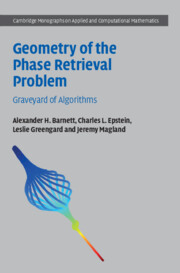Book contents
- Frontmatter
- Contents
- Preface
- Acknowledgments
- 1 Introduction
- Part I Theoretical Foundations
- Part II Analysis of Algorithms for Phase Retrieval
- 6 Introduction to Part II
- 7 Algorithms for Phase Retrieval
- 8 The Discrete, Classical, Phase Retrieval Problem
- 9 Phase Retrieval with the Nonnegativity Constraint
- 10 Asymptotics of Hybrid Iterative Maps
- Part III Further Properties of Hybrid Iterative Algorithms and Suggestions for Improvement
- References
- Index
9 - Phase Retrieval with the Nonnegativity Constraint
from Part II - Analysis of Algorithms for Phase Retrieval
Published online by Cambridge University Press: 21 April 2022
- Frontmatter
- Contents
- Preface
- Acknowledgments
- 1 Introduction
- Part I Theoretical Foundations
- Part II Analysis of Algorithms for Phase Retrieval
- 6 Introduction to Part II
- 7 Algorithms for Phase Retrieval
- 8 The Discrete, Classical, Phase Retrieval Problem
- 9 Phase Retrieval with the Nonnegativity Constraint
- 10 Asymptotics of Hybrid Iterative Maps
- Part III Further Properties of Hybrid Iterative Algorithms and Suggestions for Improvement
- References
- Index
Summary
This chapter repeats much of the analysis of the previous chapter but using the assumption that the image is nonnegative, and its autocorrelation image has sufficiently small support rather than an estimate for the support of the image itself. In this case the auxiliary set is B+, the set consisting of nonnegative images, and the intersections of A and B+ lie on the boundary of B+, which is convex but not smooth. This complicates the notion of transversality, as was discussed in Chapter 4. We then present many numerical examples exploring the behavior of algorithms using nonnegativty and also the assumption that the unknown image has a given l1-norm. The chapter concludes with an appendix describing an efficient algorithm for finding the l2-nearest point on the boundary of an l1-ball.
- Type
- Chapter
- Information
- Geometry of the Phase Retrieval ProblemGraveyard of Algorithms, pp. 191 - 204Publisher: Cambridge University PressPrint publication year: 2022

